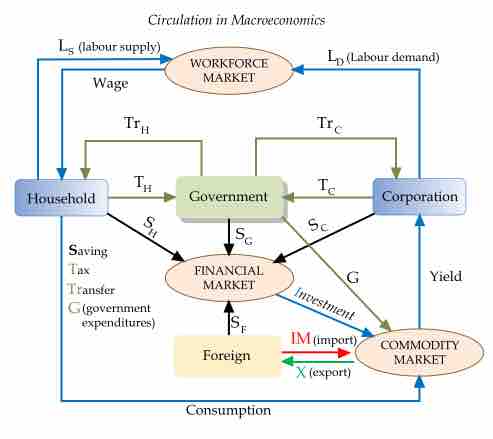Macroeconomics is the study of the performance, structure, behavior and decision-making of an economy as a whole . Macroeconomists focus on the national, regional, and global scales. For most macroeconomists, the purpose of this discipline is to maximize national income and provide national economic growth. Economists hope that this growth translates to increased utility and an improved standard of living for the economy's participants. While there are variations between the objectives of different national and international entities, most follow the ones detailed below:

Circulation in Macroeconomics
Macroeconomics studies the performance of national or global economies and the interaction of certain entities at the these level.
- Sustainability occurs when an economy achieves a rate of growth which allows an increase in living standards without undue structural and environmental difficulties.
- Full employment occurs when those who are able and willing to have a job can get one. Most economists believe that there will always be a certain amount of frictional, seasonal and structural unemployment (referred to as the natural rate of unemployment). As a result, full employment does not mean zero unemployment.
- Price stability occurs when prices remain largely stable and there is not rapid inflation or deflation. Price stability is not necessarily zero inflation; steady levels of low-to-moderate inflation is often regarded as ideal.
- External balance occurs when exports roughly equal imports over the long run.
- Equitable distribution of income and wealth among the economy's participants. This does not, however, mean that income and wealth are the same for everyone.
- Increasing Productivity over time throughout the national economy.
To achieve these goals, macroeconomists develop models that explain the relationship between factors such as national income, output, consumption, unemployment, inflation, savings, investment and international trade. These models rely on aggregated economic indicators such as GDP, unemployment, and price indices.
On the national level, macroeconomists hope that their models help address two key areas of research:
- the causes and consequences of short-run fluctuations in national income, otherwise known as the business cycle, and
- what determines long-run economic growth.